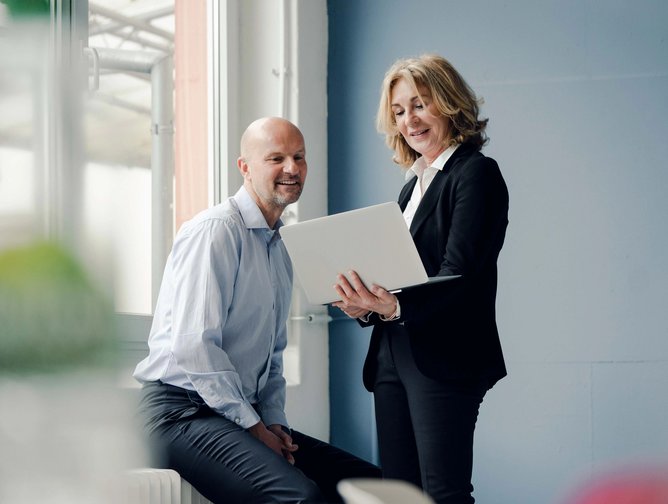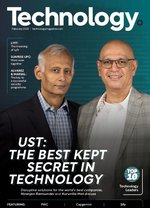UST – delivering innovative digital transformation solutions
UST could be the biggest technology firm you may never have heard of, even though it has been established for more than 20 years, has a billion-dollar-plus valuation and employs some 28,000 experts worldwide.
However, that lack of recognition does not bother Chief Technology Officer Niranjan Ramsunder, he is more than happy delivering excellence to the select roster of clients that rely on UST to provide solutions to their digital transformation problems. It’s what they do.
Ramsunder says that UST only works with a select number of clients from the Fortune 1000 who have an average tenure of 12 years with UST. Its competitors would have around two or three times the number of clients but UST feels strongly about providing more focused attention in building and maintaining both business executive and working level relationships.
“We work very deep with those companies and rely on word of mouth,” he says. “That's why we are the best-kept secret. We do not spend a lot of time publicising ourselves to a wider audience because we don’t have to.”
Ramsunder explains that part of UST’s success over the past 20 years has been built on trying to understand their customers better, by moving operations ‘to the left’ – to better understand the motivation behind business objectives rather than simply providing the solution. Adopting this approach allows UST to not only better understand its customers, but also deliver better solutions.
He talks about how technology constantly adapts and how expectations and touchpoints have increased – especially since the onset of the pandemic.
“When you look at our customers’ digital ambitions and what they want to achieve, they really want to change the way their customers perceive them and use their products and services,” says Ramsunder.
“Those digital ambitions have to be supported with what we call an initial problem discovery approach – the problem is the biggest find, it's gold for us.”
How UST does that is unique, and that is why global clients turn to UST for their biggest digital transformation challenges.
Ramsunder is a problem-solving hero and his closest ally, Kuruvilla Mat, is a future thinker steeped in experience design with a keen love for emerging technologies and how to evolve them with a focus on usefulness.
Mat is UST’s Chief Innovation Architect, and he says one key reason why customers keep coming back to UST is their ability to come up with brilliant solutions in days rather than months.
“That has always been a great interest to me – why do customers choose us?” says Mat. “What I've been able to understand is that they choose us because of the solutions that we can produce in a short period of time. When an RFP is given out, we are able to create amazing solutions in a matter of days. The comprehensiveness of the solution and the ideas that we bring to solve those problems in an elegant manner really showcases the strengths that we have.”
Without giving away too many trade secrets, this agility and speed is ‘baked in’ to UST’s way of working, and was originally born out of necessity. As a fledgling family business in 1999 with just 14 employees, teams had to be small, and that has worked so well that the model has been retained. However, UST’s winning formula is not just based on the concept of smaller teams.
Mat says they have organised their teams into small, self-organised squads that have the ability to pivot – word of the moment – in hours to refocus on the problem at hand.
“We're talking about sprints that are one-week sprints and demos that we do every day, “ he says. “We can work to a 24-hour cycle for solving certain problems and the clients see that this makes a huge difference. Our competition is not able to do that, they are able to do it at best once a week.”
Mat also talks about the advantage UST has due to having its own labs and “innovation garages” to test new products quickly. He says it is a significant differentiator, especially when clients don’t have their own environments ready.
“I've got clients that I'm working with today that don't have the environments,” he says. “By the time they get ready, time would have passed. We’ve got the labs, the software, the hardware, and we get started right away. Clients really appreciate that with UST – our commitment before contract.
Another area that UST really focuses on is on upskilling the teams to make sure they are utilising the very latest, innovative techniques and technology.
Mat recounts a story of some analysts visiting UST and noting the behaviour that its teams were exhibiting and the kind of work they were doing. What struck him was that the analysts said while they had seen this level of commitment, it was the first time they had seen genuine passion for the work.
“Everyone on the team is passionate about driving forward the solution they have come up with,” he says. The team creates journey maps but use unique methods and techniques – from dioramas to graphic novels and stop animation. It’s an unusual approach that has even caught the attention of large social media companies, checking out UST’s processes that deliver innovation and creativity at scale.
Ramsunder and Mat both talk at length about the ongoing COVID-19 pandemic and the impact it has had on the world as it has shifted to digital, but life has also changed in so many ways as consumer expectations and demands have morphed. Life in 2022 is very different from 2020, and that change is only going to accelerate as technology is utilised in new, smarter ways.
Problems and needs are different, from how people use transport to expectations around instant customer service. Even relatively new companies, seen as recent disruptors, are now in danger of falling behind – even digital banking.
Mat says some digital banking companies have changed their products and services significantly as they cater to consumers’ needs.
“As consumers, we want our banks to be catering to our needs,” he says. “I don't want to be put into constraint – if there is a constraint, I'm just going to walk off with my deposit to another bank that is going to serve my needs.
“So what we've done is we have helped understand those problems, solve those problems and then get in front of reimagining those businesses and new business models. Businesses need to provide services and build new microservices and new technologies that will really bring experiences to the customer in a much more elegant fashion. That really has been our big focus and helping clients overcome some of those challenges.”
Ramsunder says that expectation is driving change for customers and he believes it will continue to change the technology roadmap – pushing UST ahead of where they want to be as a technology company.
“I love it because we want to be ahead of where we are but we also want to provide value,” he says. “There is an opportunity to provide that value right now, whether you want to retain employees, retain your vendors and suppliers, or want to improve the experience of your end customers – all of that is being driven by phenomenal changes in underlying technology.”
Ramsunder is in his element, as a vastly experienced CTO, as the conversation shifts to Artificial Intelligence, Machine Learning, Internet of Things, Big Data, and all things cloud. Of course, many of these are inter-connected, and it is all built on cloud.
He says the biggest decision companies have to make when considering their cloud is losing control but also reducing risk in the process.
“Going to the cloud means losing control in some ways because you no longer own the hardware, you no longer own the operating system – all of that is outsourced. But against this loss in control you are not worried so much about security because the latest updates are being handled by a third party,” says Ramsunder.
“Increasing your need from AWS or Azure or Google is simple and you suddenly have the ability to deploy your solution at speed, in multiple countries, so that kind of flexibility is a key benefit.”
“How you decide on your cloud strategy is not based on an enterprise-wide position to move to the cloud but is based on specific business functionality and their future and their growth. The fundamental question is always how much control do I want to lose versus how much risk I want to reduce, and then make a choice based on the business value.”
App modernisation at UST
Business leaders reading this, especially CFOs and CTOs, may wonder what costs are associated with this constantly evolving landscape, and how that impacts existing, legacy systems. UST has created more than a billion dollars of value for its clients, while also helping them to stay relevant to their customers, and more efficient in their ways of working.
It’s not so much a nice-to-have as an essential approach for a sustainable business. However, UST believes that many organisations are misunderstanding what app modernisation entails. Mat uses the analogy of companies taking a hammer to their existing systems and beating them into a different shape rather than performing a proper assessment of their current and future needs.
Some organisations will need a transformation, others may require ongoing tweaks. Transforming everything, or hitting everything with that hammer, would be too expensive for all but the deepest pockets, and is unlikely to be required.
“We create what is known as a disposition map, and that tells you how much is it going to cost you, what kind of resources you need, what kind of business benefit you would see,” says Mat. “All these factors need to be considered as app modernisation is not just one app – it's like 700 apps built on 1,000 different technologies and it becomes really complicated really fast.”
What the future looks like for UST and its clients
When it comes to looking to the future, technology moves increasingly quickly. Ramsunder says companies can no longer afford to try and plan 10 years in advance and need to focus on the next two years. He outlines blockchain and quantum computing as particular areas of interest and opportunity, while also recognising an increased appetite for cyber security as attacks increase and companies have become more reliant on digital.
According to Mat, UST saw clients reimagine business models as they went through some serious legacy transformation and digital solutions during the pandemic, and admits that UST and its clients need to continue to pivot.
“We know now that what we thought of 12 months back, we'll have to rethink,” he says. “So the next 12 to 18 months is about making sure that we are making the right decisions for our clients – the best design choices, the best technology choices, so we are building a solution that will be in the market for a long period of time.
“Our focus is on making sure that we are executing to perfection, to make sure that all the pivots that we have to do we are doing. We're making the right choices for our clients as they go forward.”






